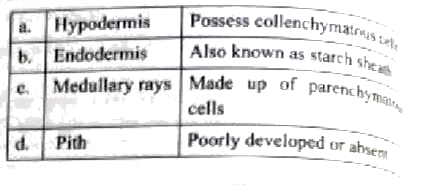Which one is correct about the dicot stem?
Pericycle consists of semilunar sclerenchymatous patches above the phloem and few layers of parenchyma alternatively
It does not show secondary growth
Endodermis is rich in starch, so this is also called starch sheath
a and c
The correct Answer is:D
To determine which statement is correct about the dicot stem, we need to analyze each option provided in the question.
1. Understanding the Structure of Dicot Stem:
- Dicot stems have a specific arrangement of tissues, including the epidermis, cortex, vascular bundles, and pith.
2. Analyzing Option 1:
- Statement: "Paricycle consists of semi-lunar sclerenchymatous patches above the phloem and few layers of parenchyma alternatively."
- Evaluation: This statement is correct. The paricycle in dicot stems is indeed made up of sclerenchyma patches and parenchyma layers.
3. Analyzing Option 2:
- Statement: "Paricycle consists of semi-lunar sclerenchyma patches above the phloem and few layers of parenchyma alternatively."
- Evaluation: This statement is identical to Option 1 and is also correct.
4. Analyzing Option 3:
- Statement: "Endodermis is rich in starch, so this is also called starch sheath."
- Evaluation: This statement is also correct. The endodermis in dicot stems can be rich in starch and is often referred to as the starch sheath.
5. Analyzing Option 4:
- Statement: (Incomplete, no information provided)
- Evaluation: Since there is no information given, we cannot evaluate this option.
Conclusion:
Options 1, 2, and 3 are correct statements about the dicot stem. However, since the question asks for "which one is correct," and we have multiple correct options, we can conclude that Options 1, 2, and 3 are valid.
- Dicot stems have a specific arrangement of tissues, including the epidermis, cortex, vascular bundles, and pith.
- Statement: "Paricycle consists of semi-lunar sclerenchymatous patches above the phloem and few layers of parenchyma alternatively."
- Evaluation: This statement is correct. The paricycle in dicot stems is indeed made up of sclerenchyma patches and parenchyma layers.
- Statement: "Paricycle consists of semi-lunar sclerenchyma patches above the phloem and few layers of parenchyma alternatively."
- Evaluation: This statement is identical to Option 1 and is also correct.
- Statement: "Endodermis is rich in starch, so this is also called starch sheath."
- Evaluation: This statement is also correct. The endodermis in dicot stems can be rich in starch and is often referred to as the starch sheath.
- Statement: (Incomplete, no information provided)
- Evaluation: Since there is no information given, we cannot evaluate this option.
Options 1, 2, and 3 are correct statements about the dicot stem. However, since the question asks for "which one is correct," and we have multiple correct options, we can conclude that Options 1, 2, and 3 are valid.
Similar Questions
Knowledge Check
In dicot stem
AVascular bundles are conjoint, open and arranged in a ringBXylem is endarchCCollenchymatous hypodermisDAllWhich statement incorrect about dicot stem?
ACollenchymatous hypodermis, sclerecnchymatous pericycle, parenchymatous pithBRing arrangement of vascualr bundles parenchymotous medullary rays and endodoermal strach sheatehCMultiple layered cortex , semi lunar pericycl,e, conjoint , open and endarch protoxylemDNone of the abovewhat is correct about monocot stem
Ahypodermis is sclerenchymatous, vascular bundles are closed, phloem parenchyma is absentBhypdermis is sclerenchymatous, vascular bundles are open,phloem parenchyma is absentChypdermis is collenchymatous vascular bundles are closed, phloem parenchyma is presentDhypodermis is sclerenchymatous, vascular bundles are closed, pholem parenchyma is present.
Which of the following statements is correct about a woody dicot stem which shows extensive secondary growth?
View SolutionSelect the incorrect option regarding dicot stem.

View Solutionsecondary Growth in dicot stems
View SolutionChoose the correct statement regarding dicot stem
View SolutionIn what respect, the pericycle of a dicot root differs from that of the dicot stem?
View Solution

